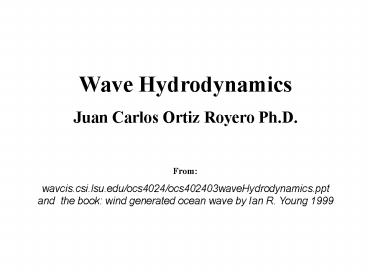Wave Hydrodynamics - PowerPoint PPT Presentation
1 / 31
Title:
Wave Hydrodynamics
Description:
Navy: Military activity, amphibious operation, ... The inner shelf is a friction-dominated zone where surface and bottom boundary layers overlap. ... – PowerPoint PPT presentation
Number of Views:1089
Avg rating:5.0/5.0
Title: Wave Hydrodynamics
1
Wave Hydrodynamics Juan Carlos Ortiz Royero
Ph.D. From wavcis.csi.lsu.edu/ocs4024/ocs402403
waveHydrodynamics.ppt and the book wind
generated ocean wave by Ian R. Young 1999
2
- Fields Related to Ocean Wave
- Ocean Engineering Ship, water borne
transport, - offshore
structures (fixed and - floating
platforms). - Navy Military activity, amphibious
operation, - Coastal Engineering Harbor and ports, coastal
structures, - beach
erosion, sediment transport
3
The inner shelf is a friction-dominated zone
where surface and bottom boundary layers overlap.
(From Nitrouer, C.A. and Wright,
L.D., Rev. Geophys., 32, 85, 1994. With
permission.)
4
Conceptual diagram illustrating physical
transport processes on the inner shelf.
(From Nitrouer, C.A. and Wright, L.D.,
Rev. Geophys., 32, 85, 1994. With permission.)
5
Approximate distribution of ocean surface wave
energy illustrating the classification of surface
waves by wave band, primary disturbance force,
and primary restoring force.
6
SEAS
Waves under the
influence of winds in a generating area SWELL
Waves moved away from
the generating area and no longer influenced by
winds
7
WAVE CHARACTERISTICS
T WAVE PERIOD Time taken for two successive
crests to pass a given point in space
8
Wave Pattern Combining Four Regular Waves
9
Linear Wave or small amplitude theory
- Assumptions
- The water is of constant depth d
- The wave motion is two-dimensional
- The waves are of constant form (do not change
with time) - The water is incompressible
- Effect of viscocity, turbulence and surface
tension are neglected. - The wave height H H / L ? 1 and H /d ? 1 ( L
is the wave length)
10
Regular Waves
11
Governing equations
- Conservation of Mass
Continuity equation, for incompressible fluids
Velocity potential
12
Governing equations
- Laplace Equation
- Navier- Stokes equation
- p is pressure
- is the water density
- ? is diffusion coefficient
13
Fluid is incompressible, no viscous,
irrotational, etc..
- Euler equation
- Unsteady Bernoulli equation
14
Boundary conditions
- Dynamic boundary condition at the free surface
- In z ?, p 0
- Kinematic boundary condition at the free surface
- In z ?, there can be no transport of fluid
through the - free surface (the vertical velocity must equal
the vertical - of the free surface
15
Boundary conditions
- Kinematic boundary condition at the bed
- In z - d, there can be no transport of fluid
through the - free surface (the vertical velocity must equal
zero)
Solution (Airy 1845, Stokes 1847)
16
Dispersion relationship
17
Deep water
Intermediate water
Shallow water
18
(No Transcript)
19
- Longer waves travel faster than shorter waves.
- Small increases in T are associated with large
increases in L. - Long waves (swell) move fast and lose
little energy. - Short wave moves slower and loses most
energy
before reaching a distant coast.
20
Example What is the fase velocity of tsunami
in deep water?
Solution The typical wave length of a tsunami
is thousand of kilometers and periods of hours.
Since the wave length of tsunami is very large
compared with the depth, then tsunami is a
shallow water wave.
21
Velocity components of the fluid particles
(HORIZONTAL)
(VERTICAL)
22
Motions of the fluid particles
23
WAVE ENERGY AND POWER
Kinetic Potential Total Energy of Wave
System Kinetic due to H2O particle
velocity Potential due to part of fluid mass
being above trough. (i.e. wave crest)
24
WAVE ENERGY FLUX(Wave Power)
- Rate at which energy is transmitted in the
direction of progradation.
25
HIGHER ORDER THEORIES
- Better agreement between theoretical and observed
wave behavior. - Useful in calculating mass transport.
- HIGHER ORDER WAVES ARE
- More peaked at the crest.
- Flatter at the trough.
- Distribution is skewed above SWL.
26
Comparison of second-order Stokes profile with
linear profile.
27
Stokes, 1847
28
Waves theories
29
Regions of validity for various wave theories.
30
Conclusions
- Linear Wave Theory Simple, good approximation
for - 70-80 engineering applications.
- Nonlinear Wave Theory Complicated, necessary for
about 20-30 engineering applications. - Both results are based on the assumption of
non-viscous flow.
31
Thanks!!































